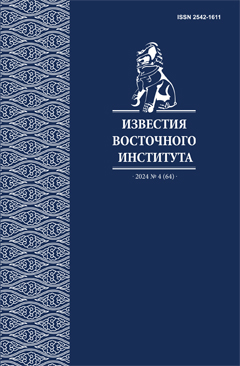Мир японской поэзии в трёхстишии Соги
DOI:
https://doi.org/10.24866/2542-1611/2024-4/71-81Ключевые слова:
японская поэзия, жанр рэнга, поэт Соги, литературная преемственность, интертекстуальностьАннотация
В статье анализируется трёхстишие Иио Соги (1421–1502), открывающее коллективную поэму из ста "нанизанных песен" (рэнга) в дневнике "Сиракава кико" ("Путешествие к заставе Сиракава", 1468). Исследуется специфика литературной преемственности в истории средневекового стиха, роль поэзии рэнга, несущей ретроспективное знание. Отмечается использование канонического метаязыка классической поэтики. С привлечением прецедентных текстов раскрываются реминисцентные свойства рэнга как интеллектуальной поэзии, основанной на ассоциативных связях с предшествующей литературой. Обнаруживаются новаторские позиции Соги ‒ родоначальника комической цепочки песен.
Скачивания
Библиографические ссылки
Боронина И. А. Поэтика классического японского стиха. М.: Наука, 1978. 372 с.
Герасимова М. П. Воображение японцев // Историческая психология и социология истории. 2016. № 1. С. 40–57.
Кин Д. Странники в веках. М.: Восточная лит., 1996. 328 с.
Кужель Ю. Л. Мир японского паломничества. М.: Книгодел, 2012. 328 с.
Манъёсю. Собрание мириад листьев / Пер. с яп. А. Е. Глускиной. М.: Наука, 1971. Т. 1. 679 с.
Странники в вечности. Японская классическая поэзия странствий / Пер. с яп. А. Долина. СПб.: Гиперион, 2012. 560 с.
Тикамацу Мондзаэмон. Драматические поэмы / Пер. с яп. В. Н. Марковой. М.: Худож. лит., 1968. 407 с.
Торопыгина М. В. Бухта песен. Шесть глав о средневековой японской поэзии. СПб.: Гиперион, 2020. 432 с.
Фатеева Н. А. Контрапункт интертекстуальности, или Интертекст в мире текстов. М.: Агар, 2000. 280 с.
Цветы, птицы, ветер и луна / Пер. с яп. А. Долина. СПб.: Азбука, 2021. 464 с.
Carter S. Sogi in the East Country: Sirakawa Kiko // Monumenta Nipponica. 1987. Vol. 42:2. Pp. 167–209.
Fujiwara Teika`s Superior Poem of Our Time. Stanford: Stanford University Press, 1967. 148 p.
Miner E. Japanese Linked Poetry. Princeton: Princeton University Press, 1979. 376 р.
Miola R. Seven Types of Intertextuality // Shakespeare, Italy, and Intertextuality. Manchester: Manchester University Press, 2004. Pp. 13‒25.
金子金次郎。宗祇の生活と作品。東京:桜風社, 1983. 328頁。 = Канэко Киндзиро. Жизнь и творчество Соги. Токио: Офуся, 1983. 328 с.
小西甚一。宗祇。東京:筑摩, 1971. 264頁。 = Кониси Дзинъити. Соги. Токио: Тикума, 1971. 264 с.
紫式部。源氏物語。東京:岩波, 1967. Т. 1. 359頁。 = Мурасаки Сикибу. Повесть о Гэндзи. Токио: Иванами, 1967. Т. 1. 359 с.
六百番歌合。東京:岩波, 2001. 500頁。 = Поэтический турнир в шестьсот пар строф. Токио: Иванами, 2001. 500 с.
連歌俳諧集。東京:小学館, 1974. 598頁。 = Собрание поэзии рэнга и хайкай. Токио: Сёгакукан, 1974. 598 с.
新古今和歌集。東京:小学館, 1979. 639頁。 = Новое собрание старых и новых японских песен. Токио: Сёгакукан, 1979. 639 с.
白河記行。 = Путешествие к заставе Сиракава. URL: http://www2s.biglobe.ne.jp/~Taiju/1468_sirakawakikou.htm (дата обращения: 17.05.2024).
たのしい万葉集。 = Антология "Манъёсю". URL: https://art-tags.net/manyo/map/isonokami.html (дата обращения 28.05.2024).





